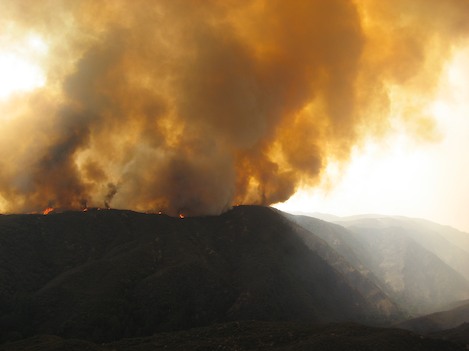The Fire and the Wild
The Zaca Fire, and the measures needed to stop it, spreads real destruction beyond trees and scrubs, effecting both lives and habitat.

Just off Highway 33, as you enter the upper Cuyama Valley, a dirt road cuts across the river leading to the Tinta OHV (off-highway vehicle) route and Rancho Nuevo Canyon, a part of the Dick Smith Wilderness. In a few days, this area will be fired out along the Cuyama River northwest to Santa Barbara Canyon. The fire is getting that close.
In early June, when I visited Rancho Nuevo Canyon, I spotted a mother bear and her three cubs. Eyeing me almost immediately, the bears scooted down the hill where the mother herded the cubs up a tall fir tree just below the trail.
At that moment, we were more concerned about getting by safely than what our impact might be once we’d moved on. Little did we realize that two months later, the bears would be threatened by a more imposing force: the Zaca Fire. The blaze has left those fighting it no choice but to initiate back-firing operations in its path. When completed, 70 percent of the vegetation could burn, possibly even the fir the bears climbed. As the fire consumes precious habitat, less and less remains for forest creatures. Even the neighboring Ventura backcountry lost a chunk of its own inhabitable territory in the Day Fire last year.
Though no one has seen any of the fire damage to other parts of the forest yet, reports of major loss of habitat are alarming. Though the top of Little Pine is silhouetted with pines, rangers say no living trees remain in the area. Indian Creek may lose almost its entire vegetative cover, as will much of the upper Santa Cruz drainage. This loss will not only be devastating to the wildlife but also could also cause erosion, sedimentation, and the loss of critical water storage. The impacts, both good and bad, will be with us for a long time.
For now, however, I am most concerned about the fate of that mother bear and her cubs.
Taken from a helicopter earlier this week, the top photo shows the very much alive and uncontrolled northeastern perimeter of the Zaca Fire, which is still burning strong near the Sisquoc River. As of press time, the fire had eaten up an area of wilderness nearly two-and-a-half times the size of Washington, D.C.a loss of habitat that has critters big and small running for cover. The bottom photo shows a bear in the Dick Smith Wilderness taken just a few months ago near Rancho Nuevo Canyon. In the coming days, in a move designed to stop the fire’s advance toward Highway 33, this very region will be methodically set on fire by U.S. Forest Service firefighters in an attempt to starve the fire.



